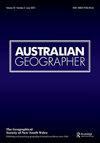评估国家干预政策对西澳大利亚小地区人口增长的影响
IF 2
2区 社会学
Q2 GEOGRAPHY
引用次数: 3
摘要
摘要2008年,西澳大利亚州政府启动了区域特许权使用费计划,为其区域发展任务提供资金。该计划是选举承诺的结果,将该州惊人的矿产特许权使用费的25%重新分配给了非大都市地区,支持者对地区条件的改善表示赞赏,批评者则声称财政不负责任。进行了大量审查,主要是定性审查,但该州审计长声称,该计划仍未得到衡量。本文根据国家的区域发展政策,对该项目的结果进行了定量分析。它调查了该计划对小型地方政府(居民少于5000人)人口的影响,以确定该计划是否促进了人口增长。这项研究使用人口普查数据来调查这些城市的人口增长如何偏离其预测增长,同时对这些地方政府的支柱——主要资源项目进行折现。研究得出的结论是,抽样人群的下降幅度通常超过预期。随后进行了讨论,质疑政府对区域发展的投资和干预政策能否在区域环境中实现人口增长。本文章由计算机程序翻译,如有差异,请以英文原文为准。
Assessing the efficacy of state interventionist policies on population growth in small Western Australian regional locales
ABSTRACT In 2008, the Western Australian State Government initiated its Royalties for Regions Program to fund its regional development mandate. The program, an outcome of an electoral commitment, reallocated 25% of the state’s prodigious mineral royalties to non-metropolitan regions, with supporters applauding the improved regional conditions and critics claiming fiscal irresponsibility. Numerous reviews, mostly qualitative, were undertaken, but the state’s Auditor-General asserted that the program remained unmeasured. This paper presents a quantitative analysis of the program’s outcomes as framed by the state’s regional development policies. It investigates the program’s influence on populations in small local governments (with fewer than 5,000 residents), where its effect would be most prominent, to determine whether the program prompted population growth. The research uses census data to examine how these municipalities’ population growth deviated from their projected growth while discounting for major resource projects – the mainstay of these local governments. The research concludes that the sampled populations typically declined more than projected. Discussion follows, questioning whether government investment and interventionist policies in regional development can achieve population growth in regional settings.
求助全文
通过发布文献求助,成功后即可免费获取论文全文。
去求助
来源期刊

Australian Geographer
GEOGRAPHY-
CiteScore
4.10
自引率
8.30%
发文量
33
期刊介绍:
Australian Geographer was founded in 1928 and is the nation"s oldest geographical journal. It is a high standard, refereed general geography journal covering all aspects of the discipline, both human and physical. While papers concerning any aspect of geography are considered for publication, the journal focuses primarily on two areas of research: •Australia and its world region, including developments, issues and policies in Australia, the western Pacific, the Indian Ocean, Asia and Antarctica. •Environmental studies, particularly the biophysical environment and human interaction with it.
 求助内容:
求助内容: 应助结果提醒方式:
应助结果提醒方式:


